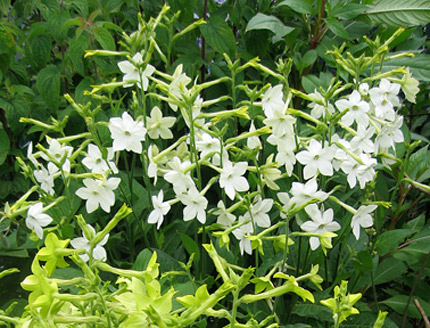I love sponge cake at Easter. It’s just the right time of year to use my violets from the garden for decorating. The best part is, it tastes as good as it looks! I used an Alice Water’s recipe for the sponge cake and topped it with whip cream and berries. It turned out beautifully!
OBSERVATIONS AND IDEAS ON BEAUTY IN EVERYDAY LIFE

Nicotiana reseeds in my garden every year. I am thankful for such generous gifts from last years flowers. The small starts are called volunteers. This is a good time to get these transplanted in a place that works in the garden design so that by summer they are established and blooming in just the right spots.
I originally enjoyed the nicotiana volunteers for three or four years when I planted seeds in the house we lived in before. This move took place 22 years ago. We had moved in the winter time so I couldn’t transplant any nicotiana plants, but, the following spring at our new house I was delighted to discover nicotiana volunteers coming up in several of the potted boxwoods we had moved.
Nicotiana (nicotiana alata grandiflora) is an old fashioned heirloom variety that has fragrance in the evening and grows three to five feet tall. It is covered with an abundance of lovely trumpet blooms that last all summer and into the fall. The flower colors vary from white and cream to many varieties of pink and an especially exquisite violet purple.
This variety like many of the nicotiana varieties that are available at plant stores is an annual, however, most of the commercially grown plants are hybrids that are compact and dwarf and do not reseed.
To date I have had over twenty five years of flowers, fragrance and beauty from one planting of one packet of seeds.

[sugar_slider id=”6″]
A very simple way to create elegance outside when you are adding potted plants to your porches, patios or focal points in the garden is to choose containers made of the same material. You don’t have to have every container in the same material but certainly the majority!
I use terra cotta because it is the classic garden pottery and has practical advantages in addition to its universal availability. Its understated elegance lets the flowers and foliage stand out. Plants are healthier when the soil can breathe through the porous walls and it is easy for excess water to drain out through the walls as well as the drainage hole in the bottom. It is almost impossible to overwater.
If you do indeed choose terra cotta, you will find so many sizes, shapes and styles to choose from. There are urns shapes, wall pockets, tall bulb pots, flat sided geometric shapes, round tubs, some with classic fluting, foliage, flower and animal designs and more incised or added to the pot surfaces. And, of course, there is always the classic rimmed flower pot available in every size from1” to 18” or more at every local nursery or garden shop.
It takes discipline to resist all of the shinny, colorful containers available at nurseries and garden shops, but actually these containers look better on the store shelves there than they will in your garden. When there are so many colors and materials in your containers, these compete with the color and splendor of the flowers and foliage. Let your plants play the staring roles in your garden and learn to have discipline in selecting unified containers. Practicing this use of repetition, one of elements of design, will create a pleasing and unified result in your garden landscape.

[sugar_slider id=”5″]
This spring I bought several Iceland poppy plants. I tucked them in front of the various boxwoods that frame my front door. I have watched with fascination the fuzzy elongated green buds open little by little and finally unfold into flowers with ruffled organza petals and golden crowns of stamens.
The fuzzy sepals that wrap around the bud to protect it before opening finally start to crack open to reveal delicate petal edges. Unlike most buds, the Iceland poppy does not unfurl or spread open, but rather it unfolds from a fist-like position with petal edges breaking out at the bottom of the sepal. To think that these gathered, gossamer thin petals emerge from this cramped position without any evidence of their captivity to appear for their grand finale of bloom is a miracle of design and engineering.

 |
CATEGORIES
WEBSITE INFORMATION
ARCHIVES
|
|
|
|
||
| © 2011 Margaret Furlong Designs. Please respect the rights of contents creators. All images are copyright of the rights holder. |
 28 April 2011
28 April 2011

